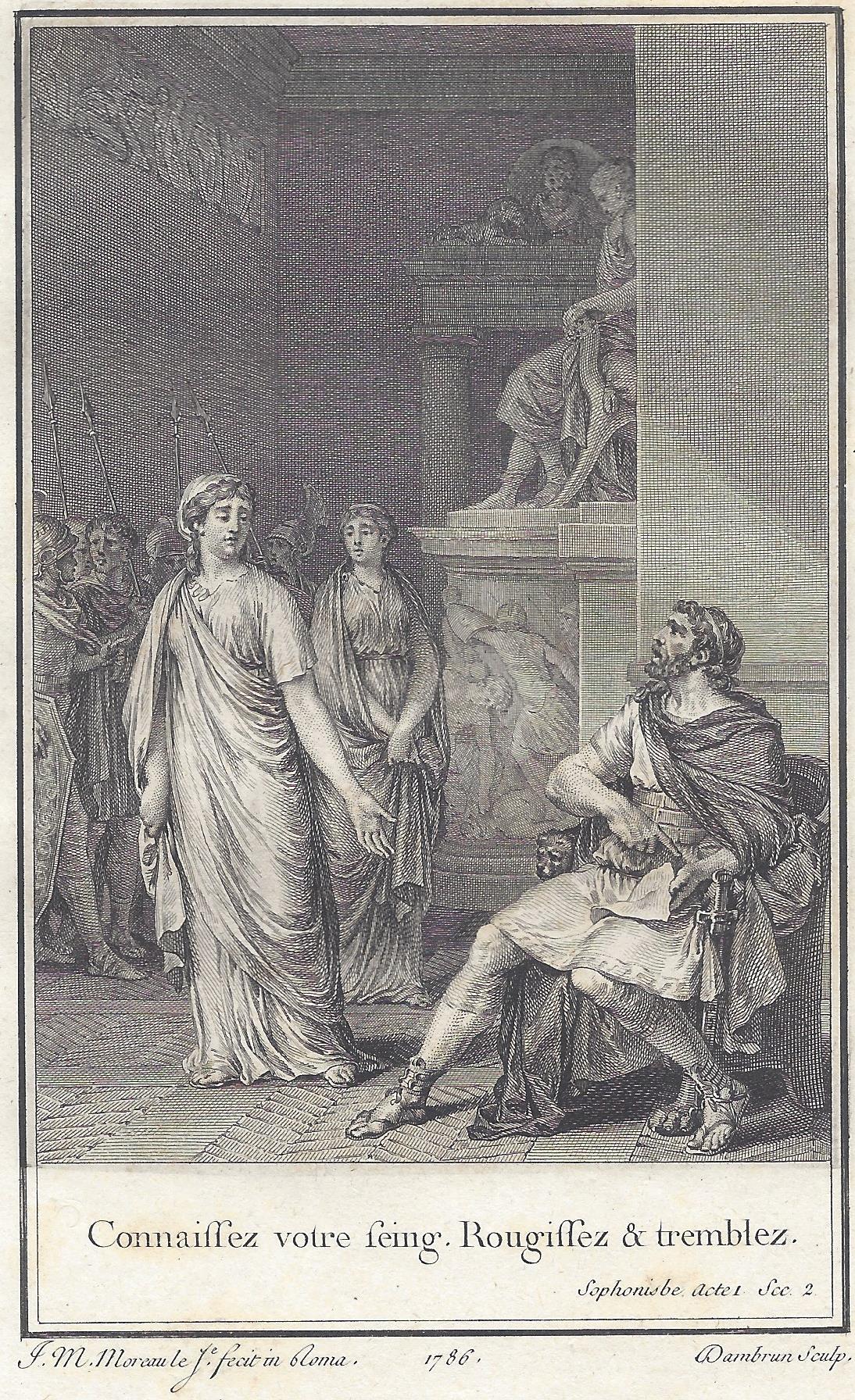Sophonisbe (tragedy) on:
[Wikipedia]
[Google]
[Amazon]
 '' Sophonisbe '' is a tragedy in five acts by Voltaire. The play, printed in 1769 but dated 1770, was a stage failure when it premiered on 15 January 1774.
'' Sophonisbe '' is a tragedy in five acts by Voltaire. The play, printed in 1769 but dated 1770, was a stage failure when it premiered on 15 January 1774.
full text of ''Sophonisbe''
scanned version of first edition
Literature on ''Sophonisbe'', Société des Etudes Voltairiennes
Plays by Voltaire Tragedy plays 1774 in France 1774 plays Phoenicia in fiction Cultural depictions of Sophonisba
 '' Sophonisbe '' is a tragedy in five acts by Voltaire. The play, printed in 1769 but dated 1770, was a stage failure when it premiered on 15 January 1774.
'' Sophonisbe '' is a tragedy in five acts by Voltaire. The play, printed in 1769 but dated 1770, was a stage failure when it premiered on 15 January 1774.
Action
The action takes places in a hall of the palace of Cirta at the time if theSecond Punic War
The Second Punic War (218 to 201 BC) was the second of three wars fought between Carthage and Rome, the two main powers of the western Mediterranean in the 3rd century BC. For 17 years the two states struggled for supremacy, primarily in Ital ...
. Sophonisbe
Sophonisba (in Punic, 𐤑𐤐𐤍𐤁𐤏𐤋 Ṣap̄anbaʿal) (fl. 203 BC) was a Carthaginian noblewoman who lived during the Second Punic War, and the daughter of Hasdrubal Gisco. She held influence over the Numidian political landscape, con ...
, daughter of Asdrubal ( Hasdrubal) is married to king Siphax (Syphax
Syphax (, ''Sýphax''; , ) was a king of the Masaesyli tribe of western Numidia (present-day Algeria) during the last quarter of the 3rd century BC. His story is told in Livy's '' Ab Urbe Condita'' (written c. 27–25 BC).
) of Numidia
Numidia ( Berber: ''Inumiden''; 202–40 BC) was the ancient kingdom of the Numidians located in northwest Africa, initially comprising the territory that now makes up modern-day Algeria, but later expanding across what is today known as Tunis ...
. Her former fiancé Massinisse ( Massinissa) defeats and kills Siphax with the help of the Romans and wants to marry Sophonisbe; Scipion ( Publius Cornelius Scipio Africanus) however wants her sent to Rome. Massinisse therefore kills both Sophonisbe and himself.Vgl. Siegfried Detemple: ''Sophonisbe'', in: ''Voltaire: Die Werke. Katalog zum 300. Geburtstag.'' Reichert, Wiesbaden 1994, pp.220f.
Literary sources
The material for the plot derives from accounts by Titus Livius,Polybius
Polybius (; grc-gre, Πολύβιος, ; ) was a Greek historian of the Hellenistic period. He is noted for his work , which covered the period of 264–146 BC and the Punic Wars in detail.
Polybius is important for his analysis of the mixed ...
and Appian, which had already been adapted into stage plays by a number of writers including Gian Giorgio Trissino (1514), Jean Mairet
Jean (de) Mairet (10 May 160431 January 1686) was a classical french dramatist who wrote both tragedies and comedies.
Life
He was born at Besançon, and went to Paris to study at the Collège des Grassins about 1625. In that year he produce ...
(1629), Pierre Corneille
Pierre Corneille (; 6 June 1606 – 1 October 1684) was a French tragedian. He is generally considered one of the three great seventeenth-century French dramatists, along with Molière and Racine.
As a young man, he earned the valuable patronag ...
(1663) and Nathaniel Lee
Nathaniel Lee (c. 1653 – 6 May 1692) was an England, English dramatist. He was the son of Dr Richard Lee, a Presbyterian clergyman who was rector of Hatfield and held many preferments under the Commonwealth of England, Commonwealth; Dr Lee was ...
(1675). Analysis of the dramatic structure and the verse indicates that Voltaire drew on a number of earlier version of the story while crafting his own.
Contemporary reception
Voltaire succeeded in having the play premiered at the Comédie-Française on 15 January 1774 but there were only four performances before it was taken off the stage. The failure of both this and his other play '' Don Pèdre, roi de Castille'' depressed him, and he took a break from writing tragedies until 1777, when he wrote '' Irène'' and '' Agathocle''.Printed edition
Voltaire had arranged the printing of the work in late 1769 with the widow Duchesne in Paris. Publication followed at the end of that year, carrying the date 1770. The work was published with the title ''Sophonisbe, Tragédie de Mairet, reparée à neuf'', Veuve Duchesne, Paris, 1770. Voltaire added an explanatory preface in which he claimed that Mairet's work had been adapted by a certain Jean-Baptiste Lantin, who had died fifty years previously, but this is certainly spurious. It may be that Voltaire was uncertain about how the theatre-going public would respond to the play, and wished to distance himself to some degree from his own creation.{{cite web , last1=Malone Feige , first1=Camilla , title=Genesis and sources of Voltaire's "Sophonisbe" , url=http://digitallibrary.usc.edu/cdm/ref/collection/p15799coll39/id/281023, website=digitallibrary.usc.edu , publisher=USC Digital Library , access-date=1 November 2018References
External links
full text of ''Sophonisbe''
scanned version of first edition
Literature on ''Sophonisbe'', Société des Etudes Voltairiennes
Plays by Voltaire Tragedy plays 1774 in France 1774 plays Phoenicia in fiction Cultural depictions of Sophonisba